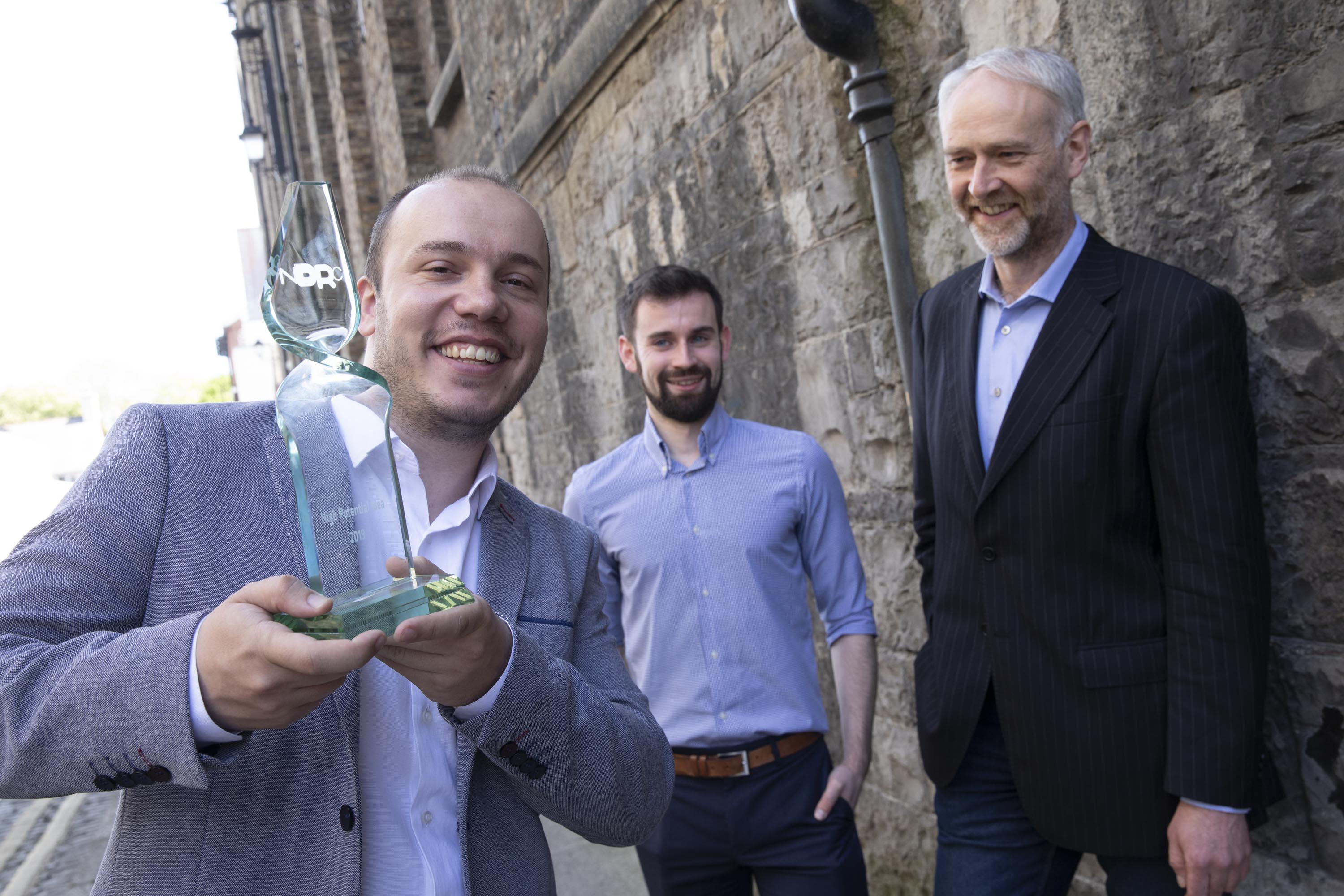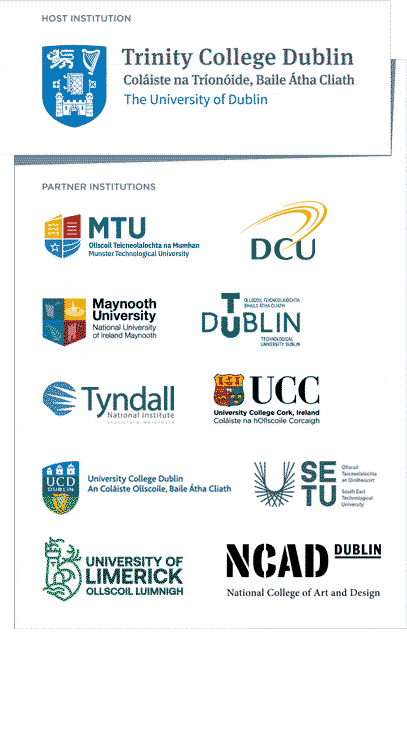
Merim and Conor with NDRC CEO, Ben Hurley. (Photo: NDRC)
NearBy, an early-stage commercialisation venture led by CONNECT researchers at Trinity College Dublin, has won the NDRC’s 2019 High Potential Idea Award. The NDRC provides early stage investment and development support to very young digital startups.
The NearBy team includes Merim Dzaferagic, Irene Macaluso, Conor Sexton, and mentor, Nicola Marchetti, Assistant Professor in Wireless Communications at Trinity College Dublin.
NearBy (Network Level Optimization Based on User Mobility) is a 4G/5G compliant solution to minimise signaling and handover latency by dynamically reconfiguring the association between nodes in the RAN and the core network’s nodes and functions.
Congratulating the NearBy team, Prof. Luiz DaSilva, Director of CONNECT, said:
“NearBy is proposing a very sophisticated solution to the problem of handover latency. This has the potential to benefit mobile phone users and network operators alike.
“I would like to acknowledge, in particular, the role of CONNECT’s IP team – Martin Johnson and Mark Cooney – who provide guidance to our researchers as they explore the commercialisation potential of their work.
“The availability of these opportunities and supports is one of the great advantages of being a researcher in a Science Foundation Ireland research centre.
“CONNECT is establishing a strong reputation for innovation: already, 17 pieces of IP have been licensed, dozens of patents have been filed, and several spin-out and spin-in companies have been generated.”
NearBy
“When you receive a call your mobile phone connects to the closest cell tower,” explains Merim Dzaferagic. “The system that take care of the user mobility is called the Mobility Management Entity (MME). As you move through a network (user mobility), for instance if you are travelling on a motorway, the MME transfers your connection to a different cell tower as you move along, ensuring that you don’t lose connection. This is called a handover. One of the problems with user mobility is the cost to the system of these handovers in terms of the signalling needed.
“Currently cell towers are grouped into geographical areas called clusters. Towers within a cluster can ‘handover’ users to each other pretty easily. So, if you are walking around the city centre in Dublin, the handover between these towers within the same cluster is ‘cheap’. There is not much information or signalling needed to transfer your call. If you transfer between different clusters though, there is more of a cost. In this scenario, there needs to be communication between multiple MMEs and other systems in the network, making it slower.
“NearBy reduces these costly handovers by using smart and adaptive optimization techniques and data on how users move around the network to reform these clusters. Based on data from the existing network, the clusters can be designed on how users actually move between towers, rather than just the geographic location. With NearBy’s technology, the cluster can be reshaped so that the towers along the motorway can be part of a single cluster, making the handovers cheaper and more efficient. It benefits the mobile users by providing a better service, it benefits the network operators by reducing the need to configure and optimise the network, and it benefits network equipment vendors by allowing best performance to be achieved.”
CONNECT also had three other entrants in the NDRC showcase, which will now continue the journey to commercialisation.
Full-duplex Node (Full-ON)
Indrakshi Dey, Nicola Marchetti, Parna Sabeti, Sandip Das, Zain Uddin
Trinity College Dublin
Major applications of 5G like intelligent transportation systems, wireless health services, smart grids, smart cities etc. will be served by huge volumes of communication nodes and end-points. These nodes can be relays, repeaters, sensors, actuators and receivers. If each of these nodes are capable of full-duplexing, huge benefits can be acclaimed including 2X spectral efficiency improvement, 2X latency minimization and 10X energy reduction. However, residual self-interference and cross-talk between transmitter and receiver are the show-stoppers in the above-mentioned scenario.
In ‘Full-ON’, a single-antenna parametric amplifier circuit design will be proposed for prototyping portable FD nodes. The proposed design will prevent the transmit signal from interfering with the received signal through signal inversion. Simulation results show that 80% increase in channel capacity is guaranteed irrespective of its position when incorporated as an FD relay as a part of Smart Grid network architectures envisioned under 5G.
AutoScale
Dr Shagufta Henna, Junaid Ali, Nikita Jalodia.
Waterford Institute of Technology
Telecommunication systems are going through a transformation currently where Cloud technologies are allowing Operators to dramatically reduce Capital Expenditure. If this way Operators can execute network functions, previously hosted on dedicated hardware, in a virtualised container and on commodity hardware. This however dramatically increases the complexity of managing such critical infrastructure to ensure robustness, efficiency and quality of service delivered. AutoScale has developed a Machine Learning approach to modelling complex ‘Virtual Service Function Chains’ allowing for accurate prediction of resources and automatic elastic scaling to ensure performance targets are met.
SmartHerd
Paul Malone, Sidhant Hasija, Mohit Taneja.
Waterford Institute of Technology
Management if lameness within herds of cattle is a considerable problem within the global industry. Prevention methods are broadly quite expensive and serve to only limit incidences marginally. Treatment of lameness is also costly when detected late, contributing to the high volumes of antibiotics consumed by the industry globally. SmartHerd is a IoT Machine Learning based Early Lameness Detection system for cattle. The system has been shown to detect early signs of lameness in cattle up to 3 days before visible signs recognisable to the farmer are observed. Early treatment of lameness has the potential to increase the productivity of the herd as well as minimise the volume of antibiotics consumed.
CONNECT is the world leading Science Foundation Ireland Research Centre for Future Networks and Communications. CONNECT is funded under the Science Foundation Ireland Research Centres Programme and is co-funded under the European Regional Development Fund. We engage with over 35 companies including large multinationals, SMEs and start-ups. CONNECT brings together world-class expertise from ten Irish academic institutes to create a one-stop-shop for telecommunications research, development and innovation.


